“We always overestimate the change that will occur in the next two years and underestimate the change that will occur in the next ten. Don't let yourself be lulled into inaction”
- Bill Gates
A decade ago, the world’s largest and fourth largest companies were oil companies, Exxon Mobil and BP. The third largest company was HSBC Bank and the sixth largest company was IBM, the inventor of mainframe computers. Entering a new decade, none of these companies are among the top 10 largest in the world; one of them isn’t even in the top 50.
This trend is not uncommon. It is very likely that many of the world’s largest companies today will not be as dominant as they once were in a decade’s time. This gives rise to risks, but also creates opportunities for investors.
Each of the risks we have identified not only has implications for share markets, be it for specific geographies and sectors, but also for another key driver of market returns, the direction of interest rate policy. With the returns of the next decade likely to be harder fought than the returns of the preceding one, we believe these risks should be at the forefront of the decision-making process of long-term investors.
1. Asia’s rising middle class
Most of the growth in the world’s middle class will come from Asia over the coming decade with India and China the largest contributors. Middle-class consumption is a key driver of global demand and consumption preferences within this group will be an important determinant of sectoral equity performance. For example, China’s growing middle class have shown a greater propensity to consume than other countries and imported products, such as cars and luxury goods, are particularly popular.
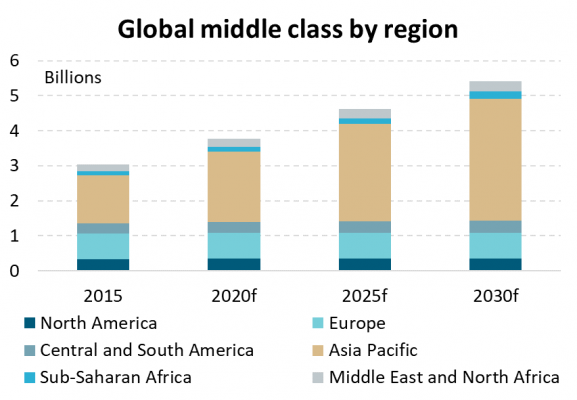
Source: Global Economy and Development, Brookings Institution: Homi Kharas, "The Unprecedented Expansion of the Global Middle Class - An Update", Working Paper 100, February 2017.
2. Healthcare
The global healthcare sector should continue to expand over the next decade as growing and ageing populations demand more from healthcare providers. This will likely be compounded by increasing rates of chronic disease, even with technological advancement helping to ease the burden. The World Health Organisation projects that, by 2020, chronic diseases will account for almost three-quarters of all deaths worldwide and 60% of the burden of chronic diseases will fall on developing countries. Global health expenditure has steadily increased since 2000 and now represents more than 6% of global GDP. Increases in the US have been particularly pronounced with the country now spending about 17% of its GDP on healthcare - 35% more than in 2000.

Source: World Health Organisation.
3. Demographics
The world’s population will continue to grow and age over the coming decade. Population growth will be led by Sub-Saharan Africa where the United Nations expects the population to increase by 40% in the next 10 years and more than triple by 2100. In contrast, Asia’s population growth will be hampered by shrinking populations in Japan and Korea from 2020. With China’s population forecast to peak in 2031, Asia population growth will become more dependent on the younger countries of India and Indonesia over the next 30 years. By 2100, the world’s population is predicted to stabilise at 10.9 billion people versus about 7.7 billion today.
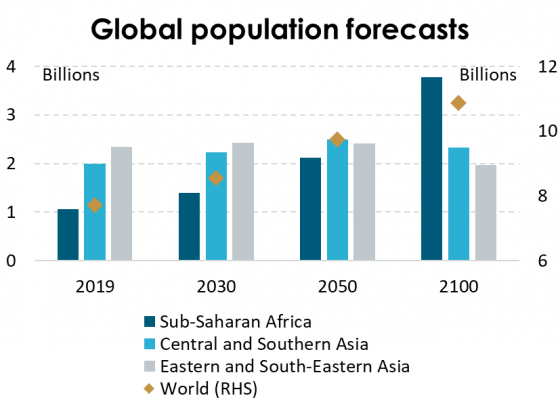
Source: United Nations, Department of Economic and Social Affairs, Population Division (2019). World Population Prospects 2019.
4. Technology – big data, 5G, AI and cloud computing:
Dramatic technological change is likely to characterise the next decade. More and more data will be available in real time and having the resource and infrastructure to analyse this will determine its usefulness for businesses. The introduction and expansion of 5G mobile broadband will vastly improve global connectivity with about 75% of all global mobile connections forecast to be 4G or better by 2025. Artificial Intelligence (AI) is already improving customer satisfaction via virtual assistance and is increasingly being applied to anticipate equipment failure and detect financial crime. Cloud computing will continue to offer flexibility and cost savings to businesses versus the traditional server-based models. Hybrid cloud computing is now offering additional flexibility by allowing data and applications to be shared between private and public cloud services.
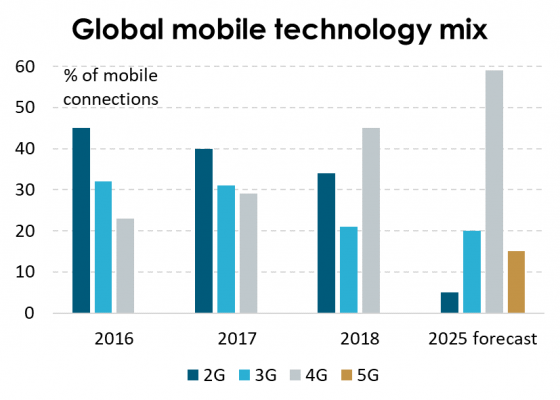
Source: GSMA.
5. ESG investing and climate change
Sustainability has become an important part of investment decisions over the past decade, with an emphasis on firms’ environmental, social and governance (ESG) policies. Google searches of related terms, for example, have increased 3-4 times in the past four years. The next decade should see improvements in technology and transparency providing investors with better data on which to base sustainable investment decisions. While consideration for the environment sits within the ESG framework, the climate has already deteriorated and will continue to impact the global economy. Greater volatility in weather conditions will impact food production, social cohesion and political stability. The insurance industry will continue to be challenged and governments that prioritise economic growth may constrain necessary environmental reform.
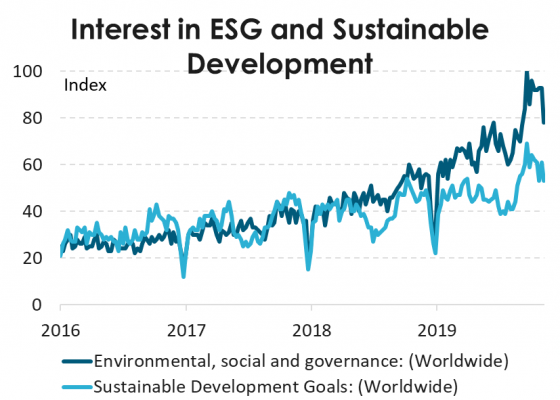
Source: Google Trends.
6. Deglobalisation
The US-China trade war is a symptom of the global rise in populism and associated desire to deglobalise. This embodies an aversion to trade, immigration and corporate influence. With middle income growth weak and inequality high, support for populism and deglobalisation is likely to persist over the coming decade. In Europe, for example, populist parties were part of government in 10 countries in 2017, versus just two in 2010.

Note: The graph shows the number of democratically elected governments in Europe year by year that includes at least one populist party. Source: TIMBRO.
7. Inequality
Global income inequality has declined since the early 1990s but the gap between rich and poor remains large. The Gini coefficient[1] is the most common income inequality metric and measures the extent to which the distribution of incomes deviates from a perfectly equal distribution. A Gini coefficient of zero represents perfect equality and 100, perfect inequality. The most recent estimates for the global economy are just above 60. There is also an increasing focus on the concentration of wealth and income among the very rich. For example, more than 20% of global income goes to the top 1% of earners.
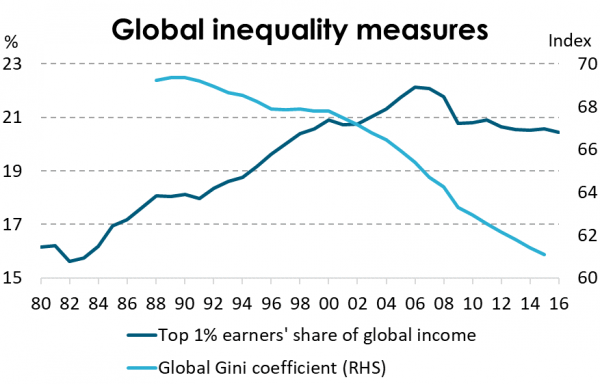
Source: World Inequality Database and Darvas, Zsolt (2019), ‘Global interpersonal income inequality decline: the role of China and India’, World Development 121, 16-32.
8. Increasing government regulation
The rapid pace of technological development will place increasing demand on global regulators and businesses over the coming decade. NZ businesses, for example, cite regulation and paperwork as the most important problem they face. Fintech, drones and self-driving cars are recent examples of innovation that have challenged existing regulatory approaches. Focus has recently shifted to more controversial areas such as regulation and censorship of social media. Even if regulation can keep pace, implementation and enforcement is critical. Environmental laws, for example, have seen a 38-fold increase since 1972 but implementation and enforcement remain major challenges.
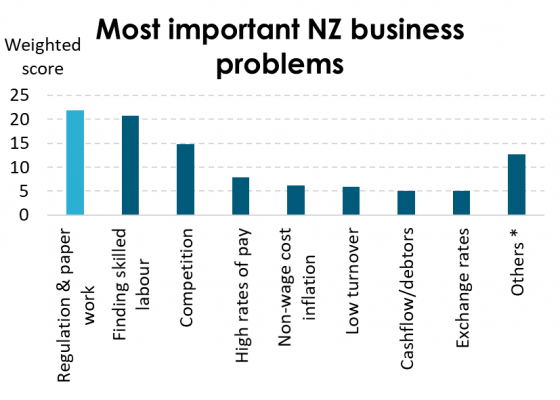
* Others includes internal management difficulties, access to finance, interest rates and other reasons not specified
Note: Weighted score is weighted using a score of 3 points for a 1st ranking, 2 for 2nd and 1 for 3rd, then scaled to 100 (i.e. a relative % weight) to allow better comparison across groups.
Source: ANZ New Zealand Business Outlook.
9. An unfavourable starting point for asset valuations
For investors, the next decade is made especially difficult because no asset class currently appears cheap. Fixed income markets are particularly unappealing with interest rates close to historic lows and credit spreads tight. Equities have a slightly less challenging outlook, with price-to-earnings multiples not extreme and equity risk premia (the additional return equities offer over fixed income) still healthy despite most markets trading at or close to historic highs.

Note: Global equities are defined as the MSCI all-country world index. Price-to-earnings ratio is based on reported (rather than forecast) earnings. Source: Bloomberg.
10. Unknown unknowns
No list of opportunities and risks for the next decade would be complete without acknowledging the myriad of things we are neither aware of nor understand.

[1] Statistical measure of inequality developed by Italian statistician Corrado Gini in 1912
IMPORTANT NOTICE AND DISCLAIMER
Harbour Asset Management Limited is the issuer and manager of the Harbour Investment Funds. Investors must receive and should read carefully the Product Disclosure Statement, available at www.harbourasset.co.nz. We are required to publish quarterly Fund updates showing returns and total fees during the previous year, also available at www.harbourasset.co.nz. Harbour Asset Management Limited also manages wholesale unit trusts. To invest as a Wholesale Investor, investors must fit the criteria as set out in the Financial Markets Conduct Act 2013. This publication is provided in good faith for general information purposes only. Information has been prepared from sources believed to be reliable and accurate at the time of publication, but this is not guaranteed. Information, analysis or views contained herein reflect a judgement at the date of publication and are subject to change without notice. This is not intended to constitute advice to any person. To the extent that any such information, analysis, opinions or views constitutes advice, it does not consider any person’s particular financial situation or goals and, accordingly, does not constitute personalised advice under the Financial Advisers Act 2008. This does not constitute advice of a legal, accounting, tax or other nature to any persons. You should consult your tax adviser in order to understand the impact of investment decisions on your tax position. The price, value and income derived from investments may fluctuate and investors may get back less than originally invested. Where an investment is denominated in a foreign currency, changes in rates of exchange may have an adverse effect on the value, price or income of the investment. Actual performance will be affected by fund charges as well as the timing of an investor’s cash flows into or out of the Fund. Past performance is not indicative of future results, and no representation or warranty, express or implied, is made regarding future performance. Neither Harbour Asset Management Limited nor any other person guarantees repayment of any capital or any returns on capital invested in the investments. To the maximum extent permitted by law, no liability or responsibility is accepted for any loss or damage, direct or consequential, arising from or in connection with this or its contents.